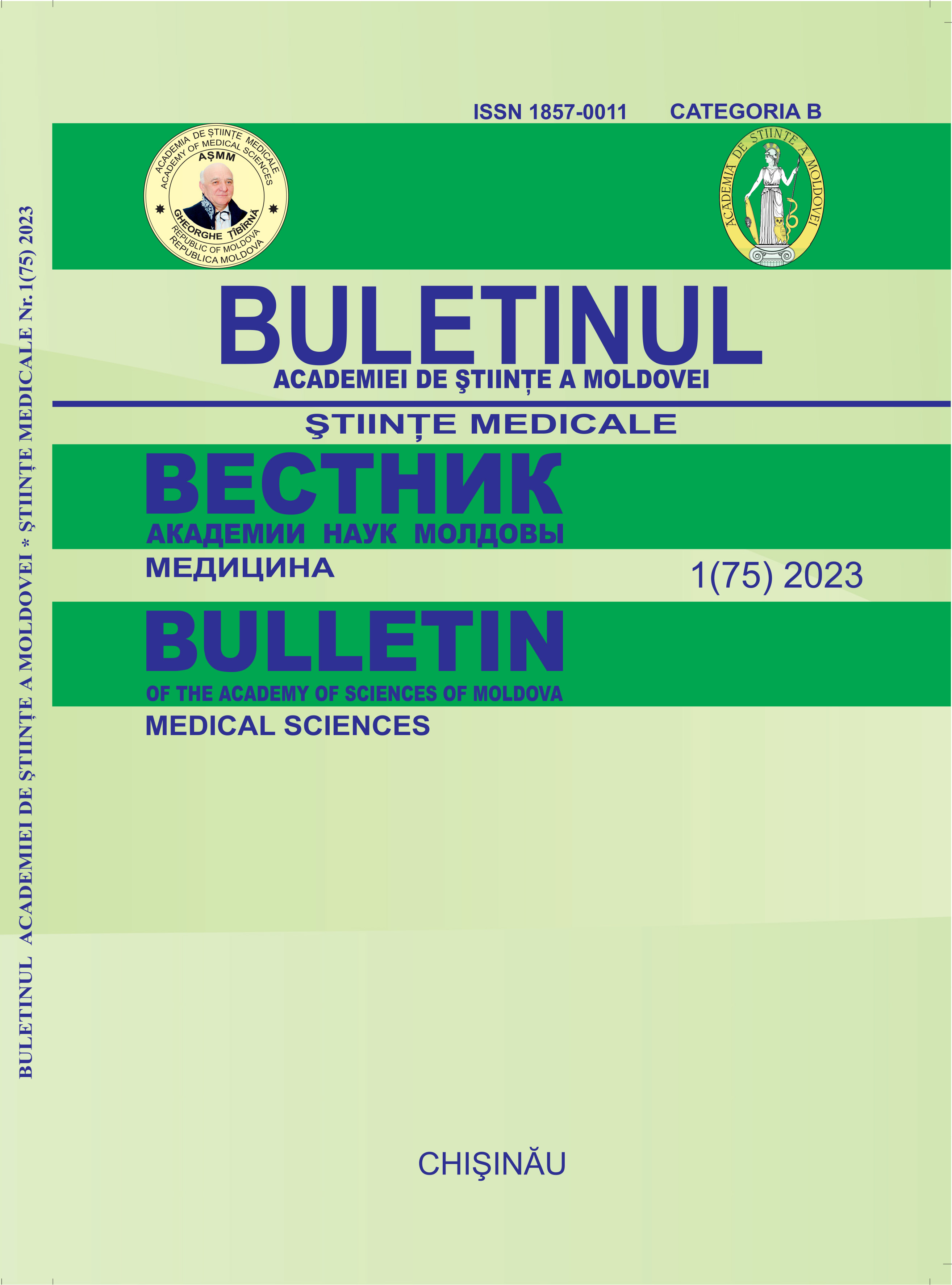Exercise capacity in patients with right ventricular dysfunction in the early stage after myocardial revascularization
DOI:
https://doi.org/10.52692/1857-0011.2023.1-75.07Keywords:
Right ventricular dysfunction, exercise capacity, cardiopulmonary exercise testingAbstract
Background. Exercise capacity is strongly associated with morbidity, as well as all-cause and cardiovascular mortality in patients with heart failure. Right ventricular dysfunction (RVD) appears to be an independent predictor of exercise intolerance, but its influence on patients’ exercise capacitiy in the early period after myocardial revascularization remains unclear. Purpose: evaluation of exercise capacity in patients with DVD 3 months after myocardial revascularization. Methods. The research is a prospective analytical study which is part of the scientific project „ALTERICC” within the State Program 2020-2023. The research included 114 patients 3 months after myocardial revascularization by coronary artery by-pass grafting or percutaneous coronary angioplasty. They were divided into 2 groups according to the presence of RVD: Gr. RVD 35 patients and Gr. non-RVD -79 patients. All patients were investigated by echocardiography, cardiopulmonary exercise testing (CPET) and 6 minute walking test (6MWT).Results. Peak oxygen consumption (VO2p) achieved by patients in the RVD group was significantly lower (1018.0±400.6 ml/min) compared to those in the non-RVD group (1243.9±336, 6 ml/min), p<0.05. VO2p related to the maximum predicted value (VO2p%) was inferior in patients with RVD (49.2±13.3% vs 58.5±15.0%), p=0.01, as well as VO2p related to body mass was lower in the RVD group (VO2p/kg 11.9±3.9 ml/min/kg vs 14.6±4.1 ml/min/kg), p=0.01. S’ RV and TAPSE correlated positively and statistically significantly with VO2p, VO2p% and VO2p/kg. Patients with RVD performed a lower distance during 6MWT (313.5±72 m vs 338.1±65.5 m). However, the results of 6MWT correlatedpositively with the work rate performed during CPET and VO2p, VO2p/kg, VO2p%.Conclusion. Exercise capacity (expressed both by maximal work rate and by VO2p, VO2p/kg, VO2p%, but also by the distance performed during TM6M) was lower in patients with RVD at 3 months after myocardial revascularization.
References
Ohara K., Teruhiko I., Hiroyuki I. Association between Right Ventricular Function and Exercise Capacity in Patients with Chronic Heart Failure. J. Clin. Med. 2022, 11, 1066.
Miller T. D., Anavekar N. Right Ventricle and Exercise Capacity More Than a Passive Conduit. Circ Cardiovasc Imaging. 2016;9:e005703
Del Buono M. G., Arena R, Borlaug B. A., Carbone S., Canada J. M., Kirkman D. L., Garten R. et al. Exercise Intolerance in Patients With Heart Failure. JACC, V ol . 73, No. 17, 2019:2209-25
Santoro C., Sorrentino R., Esposito R., Lembo M, Capone V., et al. Cardiopulmonary exercise testing and echocardiographic exam: an useful interaction. Santoro et al. Cardiovascular Ultrasound (2019) 17:29 https://doi.org/10.1186/s12947-019-0180-0
Alba A. C., Adamson M., MacIsaac J., Lalonde S., Wai S. Chan, et al. The Added Value of Exercise Variables in Heart Failure Prognosis Author links open overlay panel. Journal of Cardiac Failure. Volume 22, Issue 7, July 2016, Pages 492-49
Kinoshita M., Katsuji Inoue, Haruhiko Higashi, Yusuke Akazawa, et al. Impact of right ventricular contractile reserve during low‐load exercise on exercise intolerance in heart failure. ESC Heart Fail. 2020 Dec; 7(6): 3810–3820. doi: 10.1002/ehf2.12968
Legris V., Thibault B., Dupuis J., WhiteM., Asgar A., Fortier A., et. al. Right ventricular function and its coupling to pulmonary circulation predicts exercise tolerance in systolic heart failure. ESC Heart Failure 2022; 9: 450–464
Zhang Q., Hailin L., Shiqin Pan, Yuan Lin, Kun Zhou and Li Wang. 6MWT Performance and its Correlations with VO2 and Handgrip Strength in Home-Dwelling Mid-Aged and Older Chinese Int. J. Environ. Res. Public Health 2017, 14, 473; doi:10.3390/ijerph14050473
Solway S., Brooks D., Lacasse Y., Thomas S. A qualitative systematic overview of the measurement properties of functional walk tests used in the cardiorespiratory domain. Chest. 2001;119(1):256–70
Thomas M. G., Dirk J. van Veldhuisen, Bauersachs J., et.al. Right heart dysfunction and failure in heart failure with preserved ejection fraction: mechanisms and management. Position statement on behalf of the Heart Failure Association of the European Society of Cardiology. European Journal of Heart Failure (2018) 20, 16–37
Wanner P. M. and Filipovic M. The Right Ventricle—You May Forget It, But It Will Not Forget You. J. Clin. Med. 2020, 9, 432.
Sumin A., Shcheglova A., Korok E. and Sergeeva T. Indicators of the Right Ventricle Systolic and Diastolic Function 18 Months after Coronary Bypass Surgery. J. Clin. Med. 2022, 11, 3994.
Elserafy A., Nabil A., Ramzy A., Abdelmenem M. Right ventricular function in patients presenting with nonST-segment elevation myocardial infarction undergoing an invasive approach. The Egyptian Heart Journal, 2018; 70:149–153.
Chimed S., Pieter van der Bijl, Lustosa R. Prognostic Relevance of Right Ventricular Remodeling after ST-Segment Elevation Myocardial Infarction in Patients Treated With Primary Percutaneous Coronary Intervention. Am. J. Cardiol. 2022; 170:1−9.
Kinoshita M., Katsuji Inoue, Haruhiko Higashi, Yusuke Akazawa, et al. Impact of right ventricular contractile reserve during low‐load exercise on exercise intolerance in heart failure. ESC Heart Fail. 2020 Dec; 7(6): 3810–3820. doi: 10.1002/ehf2.12968.
Kim J., Di Franco A., Seoane T., Srinivasan A., Kampaktsis P.N., et. al. Right ventricular dysfunction impairs effort tolerance independent of left ventricular function among patients undergoing exercise stress myocardial perfusion imaging. Circ Cardiovasc Imaging. 2016; 9:e005115. doi: 10.1161/CIRCIMAGING.116.005115.
Sljivic A., Pavlovic Kleut M., Bukumiric Z., Celic V. Association between right ventricle twoand three-dimensional echocardiography and exercise capacity in patients with reduced left ventricular ejection fraction. PLoS ONE 13(6): 2018: e0199439. https://doi.org/10.1371/journal. pone.0199439.
Fossati C., D’Antoni V., Murugesan J., Fortuna D., Selli S., et al. Ventricular Dysfunction is related with Poor Exercise Tolerance in Elderly Patients with Heart Failure with Preserved Ejection Fraction. J Nov Physiother Phys Rehabil 4(1): 2017:021-026. DOI: http://doi.org/10.17352/2455-5487.000041.
Meira L., Damas C., Martins P., Gaspar L., Araújo E., Eusébio E., Gomes I. Relationship between 6MWT distance and VO2max and Wmax in lung transplant candidates undergoing pulmonary rehabilitation European Respiratory Jourl 2015 46: PA750; DOI: 10.1183/13993003. congress-2015.PA750.
Downloads
Published
License
Copyright (c) 2023 Bulletin of the Academy of Sciences of Moldova. Medical Sciences

This work is licensed under a Creative Commons Attribution 4.0 International License.



